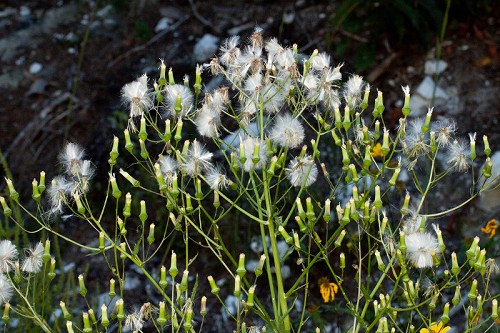Erechtites hieracifolia
| Erechtites hieracifolia | |
|---|---|

| |
| Photo by John R. Gwaltney, Southeastern Flora.com | |
| Scientific classification | |
| Kingdom: | Plantae |
| Division: | Magnoliophyta - Flowering plants |
| Class: | Magnoliopsida - Dicotyledons |
| Order: | Asterales |
| Family: | Asteraceae ⁄ Compositae |
| Genus: | Erechtites |
| Species: | E. hieracifolia |
| Binomial name | |
| Erechtites hieracifolia (L.) Raf. ex DC. | |

| |
| Natural range of Erechtites hieracifolia from USDA NRCS Plants Database. | |
Common name: American burnweed; fireweed
Contents
Taxonomic notes
Synonym: Erechtites hieracifolia var. hieracifoliaThe Plant List.org; E. hieracifolia var. intermedia Fernald; E. hieracifolia var. praealta (Rafinesque) Fernald; E. hieracifolia; Senecio hieraciifolius Linnaeus
Description
"Robust annual with erect, glabrous or slightly pubescent, solid stems, 0.4-3 m or more tall. Leaves alternate, elliptic to lanceolate, 5-20 cm long, 0.5-6.5 cm wide, acute to acuminate, irregularly serrate to dentate, unlobed or lobed, base cuneate to attenuate or upper stem leaves auriculate. Heads in panicles. Involucres cylindric, 10-20 mm long, 4-8 mm broad; bracts in 1 series or with a few small bracts at base. Disc 3-10 mm broad. Flowers discoid, lobes cream to pinkish, erect, 0.3-0.5 mm long. Nutlets brown, tapered from base to apex, 1.9-2.7 mm long, 0.4-0.7 mm broad, 10-ribbed, pubescent; pappus white, capillary, 10-14 mm long." [1]
Distribution
This species can be found from Canada southward, from Newfoundland west to Saskatchewan provinces south to southern Florida and eastern Texas. It is also native south of the United States including the West Indies and Tropical America.[2] It has also been introduced to Hawaii.[3]
Ecology
Habitat
Can be found in almost all habitats in disturbed soil besides extremely xeric soils. It is present in most areas of modern beat-up landscapes (even if just seedlings) and appears at the smallest disturbance. With this, it is most prevalent in areas that are heavily disturbed or scarified by timber-harvest, bulldozing, and severe fire disturbance.[2]
Phenology
Generally, this species flowers from late July until November.[2] E. hieracifolia has been obseved flowering in all months besides February and May, and has been observed fruiting in March, April, and June through October.[4][5]
Seed dispersal
This species is thought to be dispersed by wind. [6]
Seed bank and germination
E. hieracifolia was found in the seed banks of bays dominated by herbaceous and shrub plants in western South Carolina. [7]
Pollination
The following Hymenoptera families and species were observed visiting flowers of Erechtites hieracifolia at Archbold Biological Station. [8]
Halictidae: Halictus poeyi
Leucospididae: Leucospis affinis
Megachilidae: Dianthidium floridiense
Vespidae: Leptochilus republicanus, Parancistrocerus bicornis, P. salcularis rufulus, Polistes dorsalis hunteri
Use by animals
It consists of approximately 2-5% of the diet for various terrestrial birds.[9]
Conservation and management
Cultivation and restoration
Photo Gallery
Erechtites hieracifolia Photo by John R. Gwaltney, Southeastern Flora.com
Erechtites hieracifolia Photo by John R. Gwaltney, Southeastern Flora.com
References and notes
- ↑ Radford, Albert E., Harry E. Ahles, and C. Ritchie Bell. Manual of the Vascular Flora of the Carolinas. 1964, 1968. The University of North Carolina Press. 1037. Print.
- ↑ 2.0 2.1 2.2 Weakley, A. S. (2015). Flora of the Southern and Mid-Atlantic States. Chapel Hill, NC, University of North Carolina Herbarium.
- ↑ USDA, NRCS. (2016). The PLANTS Database (http://plants.usda.gov, 8 May 2019). National Plant Data Team, Greensboro, NC 27401-4901 USA.
- ↑ Nelson, G. PanFlora: Plant data for the eastern United States with emphasis on the Southeastern Coastal Plains, Florida, and the Florida Panhandle. www.gilnelson.com/PanFlora/ Accessed: 8 DEC 2016
- ↑ Florida State University Robert K. Godfrey Herbarium database. URL: http://herbarium.bio.fsu.edu. Last accessed: May 2019. Collectors: Loran C. Anderson, Kurt E. Blum, D. E. Breedlove, Jane Brockmann, K. Craddock Burks, A. F. Clewell, J. Dwyer, J. Ferborgh, R. K. Godfrey, Ann F. Johnson, Brian R. Keener, R. Komarek, Robert J. Lemaire, Horace Loftin, Marc Minno, - Mitchell, R. S. Mitchell, R. A. Norris, Gwynn W. Ramsey, Paul L. Redfearn, Jr., Grady W. Reinert, Annie Schmidt, Cecil R. Slaughter, H. Larry Stripling, - Thompson, Alush Shilom Ton, and Edwin L. Tyson. States and Counties: Florida: Bay, Calhoun, Dade, Dixie, Franklin, Gulf, Hernando, Hillsborough, Indian River, Jackson, Jefferson, Leon, Liberty, Madison, Nassau, Okaloosa, Polk, Sarasota, St Johns, Taylor, Volusia, Wakulla, and Washington. Georgia: Grady and Thomas. Alabama: Baldwin.
- ↑ Kirkman, L. Katherine. Unpublished database of seed dispersal mode of plants found in Coastal Plain longleaf pine-grasslands of the Jones Ecological Research Center, Georgia.
- ↑ Navarra, J. J. and P. F. Quintana-Ascencio 2012. Spatial pattern and composition of the Florida scrub seed bank and vegetation along an anthropegenic disturbance gradient. Applied Vegetation Science 15:349-358.
- ↑ Deyrup, M.A. and N.D. 2015. Database of observations of Hymenoptera visitations to flowers of plants on Archbold Biological Station, Florida, USA.
- ↑ Miller, J.H., and K.V. Miller. 1999. Forest plants of the southeast and their wildlife uses. Southern Weed Science Society.

